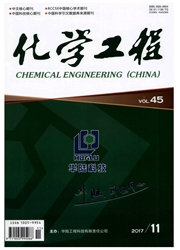

 中文摘要:
中文摘要:
采用溶胶-凝胶法对SDR转盘表面进行催化剂的负载,并对负载后的SDR进行光催化降解含酚废水的研究。考察了溶剂、加水量、抑制剂等因素对胶凝时间的影响,得出了制备催化剂薄膜的适宜条件为:n(钛)∶n(水)∶n(乙醇)∶n(盐酸)∶n(冰醋酸)=1∶2∶13.56∶0.05∶1,随后采用XRD、SEM对薄膜进行了表征,结果显示负载的催化剂为粒度分布均匀的锐钛矿型TiO2。进一步研究了SDR中H2O2、UV/H2O2、UV/TiO2、UV/H2O2/TiO2等4种条件下苯酚的降解率和后2种情况下苯酚的矿化率的对比。结果表明:H2O2/TiO2光催化氧化30 min苯酚降解率达到100%,与UV/H2O2氧化条件下相比,完全降解时间缩短了30 min,与UV/TiO2氧化相比,苯酚降解率有大幅度提高;UV/H2O2/TiO2催化氧化条件下2 h的矿化率为89%,较UV/H2O2光氧化条件下提高28%。
 英文摘要:
英文摘要:
TiO2 photocatalytic film was coated on the disk surface of the SDR( spinning disc reactor) by sol-gel method,and then used to degrade phenol wastewater. The effects of different solvents,amount of water and inhibitors on the gelation time were investigated. The optimal ratio of raw material for film preparation was obtained: n( titanium) ∶ n( water) ∶ n( ethanol) ∶ n( hydrochloric acid) ∶ n( acetic acid) = 1∶ 2∶ 13. 56∶ 0. 05∶ 1. The synthesized TiO2 thin film was characterized by SEM,XRD and the results showed that the loaded catalyst was uniform anatase TiO2. The degradation rate and mineralization rate of phenol wastewater were studied under four different conditions: oxidation degradation by H2O2,UV/H2O2,UV/TiO2 and UV / H2O2/ TiO2. The results showed that phenol was almost degraded completely by H2O2/ TiO2 after 30 minutes,and its degradation time was30 minutes shorter than UV / H2O2. The degradation rate increased greatly compared with that in UV / TiO2.Moreover,the mineralization rate in UV / H2O2/ TiO2 was 89%,which was about 28% higher than that in UV /H2O2.
 同期刊论文项目
同期刊论文项目
 同项目期刊论文
同项目期刊论文
 期刊信息
期刊信息
